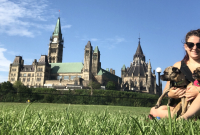Time to stop treating students and their debt as cash cows

When Prime Minister Justin Trudeau announced the extension of certain COVID-19 benefits on Feb. 19, his reasoning was simple: “This crisis isn’t over. So neither is our support for you.”
Words of solace — so long as you’re not one of hundreds of thousands of Canadians managing student loan debt during the pandemic. And if you are, then consider yourself an unwilling cash cow for the federal government.
If anything, the Trudeau government’s refusal to offer ongoing COVID-19 relief to student loan borrowers is indicative of a larger problem plaguing post-secondary education in the last few decades: Student debt is profitable. According to the most recently available data from Statistics Canada, due to be updated later this year, one in two Canadians graduate with government-owed student loan debt averaging $26,000 — generating hundreds of millions of dollars a year in student loan interest.
But it’s not just our government that benefits from this. DH Corp. (now Finastra, a U.K.-based, U.S.-owned private company) is paid tens of millions of dollars a year by the federal government to administer the National Student Loans Service Centre (NSLSC). Tens of millions of dollars a year lost from our economy, spent on keeping Canada’s student loan debt alive.
Canada’s moratorium on student loan payments and interest ended nearly half a year ago, on Sept. 30. The country’s post-secondary class of 2020 never even benefited — all new graduates are given a six-month grace period on federal loan repayments, and theirs overlapped with the COVID-19 freeze.
The impact of the pandemic on new graduates alone is cause for concern. Not only does Statistics Canada estimate that one in three students lost work placements last spring due to COVID-19, the federal agency also projects the class of 2020 could lose $25,000 or more over the next five years because of the pandemic. Many new graduates didn’t qualify for and never saw the summer job benefits promised to them after the WE scandal unfolded. Most of the $9-billion government aid package allocated last year to students and new grads has yet to be spent.
Despite this, the collection of loan payments continues in full force. And while the NSLSC offers a repayment assistance plan (RAP) to anyone struggling, it has completely collapsed under the weight of the pandemic. Search #nslsc or #freezethenslsc on Twitter, and you’ll find countless stories of payments being charged when they shouldn’t have been, multi-hour waits on hold trying to reach a human who can help and other technical issues causing more problems than they can resolve. Consider, too, that the assistance plan is an opt-in program — which means that every six months, struggling borrowers have no choice but to repeat the arduous application process.
One temporary solution would bring all of this to a stop: Freeze student loan payments and interest during COVID-19. So why is our government insistent on collecting student loan payments during a global pandemic? Since when did debt-ridden graduates and unemployed Canadians become such a lucrative cash cow?
It’s ineffective to continue labelling student loan debt as an individual problem while ignoring the systemic changes that have led to a greater reliance on student loans in the first place. The public defunding of Canada’s post-secondary system over the last several decades, and the subsequent rise in tuition and individual education costs, is well-documented. The stories of earning enough from a summer job to pay for a year’s worth of education costs, mostly recounted by older Canadians, are a distant past.
Instead, the student loan debt burdening younger Canadians is preventing them from homeownership, retirement savings, investing and other generational milestones that are meant to fuel the Canadian economy. Student loan debt is ironically closing many of the doors that a good education and a well-paying job are usually meant to open.
Whether you agree with cancelling Canada’s student debt, a freeze on loan payments and interest is far from full forgiveness. It’s bare-minimum relief in the form of time — much-needed time for recent graduates and underemployed Canadians to find the financial footing they need to join the workforce and participate in Canada’s economy as we continue to contend with COVID-19.
Without a student loan freeze, quips like “my biggest worry is young people” (as Employment Minister Carla Qualtrough was quoted saying in a December op-ed) ring hollow when the government continues to ignore the ongoing strains that affect the very people they are speaking for.
Trudeau’s government had an opportunity to take action on Nov. 24 when a motion by NDP MP Heather McPherson to extend the freeze on loan payments passed unanimously in the House of Commons. Instead, the radio silence of the Liberal government has continued, and the quiet collection of loan payments speaks volumes about our current government’s priorities: Profits over students, recent graduates and student loan borrowers.
Patty Facy is a Toronto-based digital service designer and organizer of the #FreezeTheNSLSC campaign.






Comments